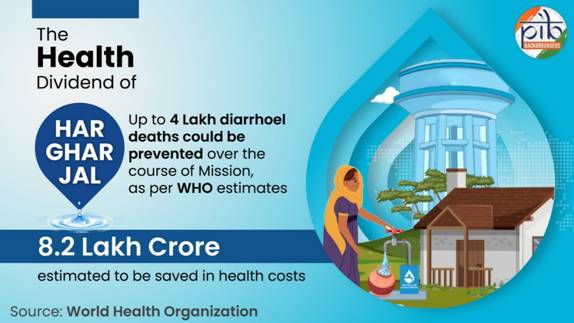Jal Jeevan Mission — Delivering Tap Water to Over 15.72 Crore Rural Households

IN NEWS: Jal Jeevan Mission — Delivering Tap Water to Over 15.72 Crore Rural Households
Analysis
- Recent Development
- As of 22 October 2025, over 15.72 crore rural households have access to safe tap water under the Jal Jeevan Mission (Har Ghar Jal).
- At the time of the Mission’s launch in 2019, only 3.23 crore households (16.71%) had tap water connections, indicating an addition of 12.48 crore households in just six years.
- The Government of India has provided a central outlay of ₹2,08,652 crore, marking one of the largest infrastructure expansions in rural India.
- Objective and Vision
- To ensure functional household tap connections (FHTCs) to every rural household.
- To reduce the drudgery of women involved in fetching water, thereby improving their health, education, and socio-economic status.
- To promote ease of living and dignity in rural areas by ensuring sustainable access to safe drinking water.
- Community and Sustainability Focus
- The Mission emphasizes community participation and source sustainabilitythrough:
- Greywater management and reuse.
- Water conservation and rainwater harvesting.
- IEC (Information, Education, Communication) activities for awareness and ownership.
- It aims to create a jan andolan (people’s movement) for water conservation and supply management.
- The Mission emphasizes community participation and source sustainabilitythrough:
- Progress Report (as of 22 October 2025)
- District Coverage: 192 districts have full household coverage; 116 certified by Gram Sabha.
- Block & Panchayat Coverage: 1,912 blocks reported full coverage (1,019 certified); 1,25,185 GPs reported coverage (88,875 certified).
- Village Coverage: 2,66,273 villages reported coverage, with 1,74,348 certified under Har Ghar Jal.
- States/UTs with 100% Coverage: Goa, Andaman & Nicobar Islands, Dadra & Nagar Haveli & Daman & Diu, Haryana, Telangana, Puducherry, Gujarat, Himachal Pradesh, Punjab, Mizoram, and Arunachal Pradesh.
- Institutional Coverage: Tap water in 9,23,297 schools and 9,66,876 Anganwadi centres.
- Quality Assurance and Monitoring
- 2,843 laboratories (2,184 institutional + 659 WTP-based) tested 38.78 lakh samples in 2025–26 across 4,49,961 villages.
- 24.80 lakh women trained to use Field Testing Kits (FTKs) across 5.07 lakh villages, ensuring local-level quality assurance.
- This decentralised approach enhances transparency and early detection of contamination.
- Technological and Digital Governance Reforms
- Launch of Rural Piped Water Supply Schemes (RPWSS) module to create a Digital Registry for all water schemes.
- Integration with GIS mapping and PM Gati Shakti platform for data-driven monitoring and real-time dashboards.
- Each water scheme to be assigned a unique RPWSS ID by November 2025 for traceability and accountability.
- The ‘Jal Mitra’ app (West Bengal) has revolutionised MIS-based community water management, tracking 13.7 crore activities across 22,111 villages.
- Impact Assessment
- WHO Findings:
- Potential to avert 4 lakh diarrhoeal deaths and 14 million DALYs.
- Saves 5.5 crore hours daily, predominantly benefiting women.
- SBI Research:
- 8.3 percentage-point decline in households fetching water from outside.
- 9 crore women freed from the burden of water collection.
- 7.4 percentage-point increase in women’s participation in agriculture and allied activities.
- IIM Bangalore & ILO:
- Potential to generate 3 crore person-years of employment during build-out phase.
- 25 lakh women trained for water testing and local management roles.
- Nobel laureate Michael Kremer: Safe water access can reduce under-five mortality by 30%, saving over 1 lakh lives annually.
- WHO Findings:
- Community-led Success Stories
- Maharashtra: Women’s SHG “Amritnath Mahila Samuha” manages water supply system, achieving 100% bill recovery and self-sustainability.
- Nagaland: Wokha district follows a “people-first, source-first” model, combining catchment protection with afforestation.
- Assam: Borbori village achieved zero waterborne illness after JJM intervention and hygiene awareness campaigns.
- Rajasthan: Bothara village adopted a ridge-to-valley water conservation approach, resulting in a 70-ft rise in groundwater levels post-check dam construction.
- West Bengal: ‘Jal Mitra’ MIS ensures participatory, data-driven water management with formation of 4,522 Jal Bachao Committees.
- Significance
- Jal Jeevan Mission has evolved as a key socio-economic reform improving rural health, livelihoods, and women’s empowerment.
- It promotes inclusive governance, technology-led transparency, and community ownership.
- The Mission has emerged as a benchmark for people-centric infrastructure programmes.
- Challenges and Way Forward
- Ensuring long-term source sustainability amidst depleting groundwater.
- Building capacities for local-level operation and maintenance.
- Strengthening real-time quality monitoring systems and inter-departmental convergence.
- Expanding digital water governance models nationwide.
Static/Background Information
- Launched: 15 August 2019 by Prime Minister Narendra Modi.
- Implementing Ministry: Ministry of Jal Shakti.
- Mission Goal: Functional tap water connection to every rural household by 2024 (target extended to ensure quality and sustainability).
- Coverage (as of Oct 2025): 81% of rural households.
- Service Standard: Minimum 55 litres per capita per day (lpcd).
- Approach: Community-managed, sustainability-driven, digitally monitored.
- Global Alignment: Contributes to SDG 6 – Clean Water and Sanitation.



Updated – 26 Oct 2025 ; 11:08 AM | PIBSource:Press Information Bureau (PIB)